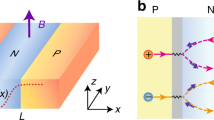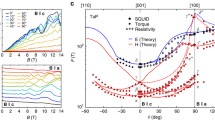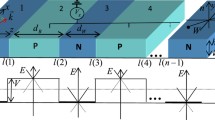Abstract
We compute the transmission coefficients and zero-temperature conductance for chiral quasiparticles propagating through various geometries, which consist of junctions of three-dimensional nodal point semimetals. In the first scenario, we consider a potential step with two Rarita–Schwinger–Weyl or two birefringent semimetals, which are tilted with respect to the other on the two sides of the junction. The second set-up consists of a junction between a doped Dirac semimetal and a ferromagnetic Weyl semimetal, where an intrinsic magnetization present in the latter splits the doubly-degenerate Dirac node into a pair of Weyl nodes. A scalar potential is also applied in the region where the Weyl semimetal phase exists. Finally, we study sandwiches of Weyl/multi-Weyl semimetals, with the middle region being subjected to both scalar and vector potentials. Our results show that a nonzero transmission spectrum exists where the areas, enclosed by the Fermi surface projections (in the plane perpendicular to the propagation axis) of the incidence and transmission regions, overlap. Such features can help engineer unidirectional carrier propagation, topologically protected against impurity backscattering, because of the chiral nature of the charge carriers.











Similar content being viewed by others
Data availability
No data was used for the research described in the article.
Notes
As usual, \(\varvec{\sigma }\) represents the vector of the three Pauli matrices, such that the Weyl semimetal hosts pseudospin-1/2 quasiparticles.
We note that \(J=1\) for Weyl semimetals, making the dispersion isotropic.
References
B. Bradlyn, J. Cano, Z. Wang, M.G. Vergniory, C. Felser, R.J. Cava, B.A. Bernevig, Beyond Dirac and Weyl fermions: unconventional quasiparticles in conventional crystals. Science 353, aaf5037 (2016)
C. Fang, M.J. Gilbert, X. Dai, B.A. Bernevig, Multi-Weyl topological semimetals stabilized by point group symmetry. Phys. Rev. Lett. 108, 266802 (2012). https://doi.org/10.1103/PhysRevLett.108.266802
L. Liang, Y. Yu, Semimetal with both Rarita-Schwinger-Weyl and Weyl excitations. Phys. Rev. B 93, 045113 (2016). https://doi.org/10.1103/PhysRevB.93.045113
M.P. Kennett, N. Komeilizadeh, K. Kaveh, P.M. Smith, Birefringent breakup of Dirac fermions on a square optical lattice. Phys. Rev. A 83, 053636 (2011). https://doi.org/10.1103/PhysRevA.83.053636
B. Roy, M.P. Kennett, K. Yang, V. Juričić, From birefringent electrons to a marginal or non-fermi liquid of relativistic spin-\(1/2\) fermions: an emergent superuniversality. Phys. Rev. Lett. 121, 157602 (2018). https://doi.org/10.1103/PhysRevLett.121.157602
I. Mandal, Robust marginal fermi liquid in birefringent semimetals. Phys. Lett. A 418, 127707 (2021). https://doi.org/10.1016/j.physleta.2021.127707
S. Weinberg, The quantum theory of fields. Vol. 3: Supersymmetry, Cambridge University Press, (2013)
I. Boettcher, Interplay of topology and electron-electron interactions in Rarita-Schwinger-Weyl semimetals. Phys. Rev. Lett. 124, 127602 (2020). https://doi.org/10.1103/PhysRevLett.124.127602
J.M. Link, I. Boettcher, I.F. Herbut, \(d\)-wave superconductivity and Bogoliubov-Fermi surfaces in Rarita-Schwinger-Weyl semimetals. Phys. Rev. B 101, 184503 (2020). https://doi.org/10.1103/PhysRevB.101.184503
I. Mandal, Transmission in pseudospin-1 and pseudospin-3/2 semimetals with linear dispersion through scalar and vector potential barriers. Phys. Lett. A 384, 126666 (2020). https://doi.org/10.1016/j.physleta.2020.126666
G. Xu, H. Weng, Z. Wang, X. Dai, Z. Fang, Chern semimetal and the quantized anomalous Hall effect in HgCr\(_{2}\)Se\(_{4}\). Phys. Rev. Lett. 107, 186806 (2011). https://doi.org/10.1103/PhysRevLett.107.186806
S.-M. Huang, S.-Y. Xu, I. Belopolski, C.-C. Lee, G. Chang, B. Wang, N. Alidoust, G. Bian, M. Neupane, C. Zhang et al., A Weyl fermion semimetal with surface fermi arcs in the transition metal monopnictide TaAs class. Nat. Commun. 6, 7373 (2015). https://doi.org/10.1038/ncomms8373
S.-Y. Xu, I. Belopolski, N. Alidoust, M. Neupane, G. Bian, C. Zhang, R. Sankar, G. Chang, Z. Yuan, C.-C. Lee et al., Discovery of a Weyl fermion semimetal and topological Fermi arcs. Science 349, 613–617 (2015). https://doi.org/10.1126/science.aaa9297
S.-M. Huang, S.-Y. Xu, I. Belopolski, C.-C. Lee, G. Chang, T.-R. Chang, B. Wang, N. Alidoust, G. Bian, M. Neupane, D. Sanchez, H. Zheng, H.-T. Jeng, A. Bansil, T. Neupert, H. Lin, M.Z. Hasan, New type of Weyl semimetal with quadratic double Weyl fermions. Proc. Natl. Acad. Sci. 113, 1180 (2016). https://doi.org/10.1073/pnas.1514581113
G. Volovik, https://books.google.pl/books?id=6uj76kFJOHEC The Universe in a Helium Droplet, International Series of Monographs on Physics, OUP Oxford, (2009)
P. Goswami, A.H. Nevidomskyy, Topological Weyl superconductor to diffusive thermal Hall metal crossover in the B phase of UPt\(_{3}\). Phys. Rev. B 92, 214504 (2015). https://doi.org/10.1103/PhysRevB.92.214504
M.H. Fischer, T. Neupert, C. Platt, A.P. Schnyder, W. Hanke, J. Goryo, R. Thomale, M. Sigrist, Chiral \(d\)-wave superconductivity in SrPtAs. Phys. Rev. B 89, 020509 (2014). https://doi.org/10.1103/PhysRevB.89.020509
B. Roy, S.A.A. Ghorashi, M.S. Foster, A.H. Nevidomskyy, Topological superconductivity of spin-\(3/2\) carriers in a three-dimensional doped Luttinger semimetal. Phys. Rev. B 99, 054505 (2019). https://doi.org/10.1103/PhysRevB.99.054505
Q. Liu, A. Zunger, Predicted realization of cubic Dirac fermion in quasi-one-dimensional transition-metal monochalcogenides. Phys. Rev. X 7, 021019 (2017). https://doi.org/10.1103/PhysRevX.7.021019
D. Takane, Z. Wang, S. Souma, K. Nakayama, T. Nakamura, H. Oinuma, Y. Nakata, H. Iwasawa, C. Cacho, T. Kim, K. Horiba, H. Kumigashira, T. Takahashi, Y. Ando, T. Sato, Observation of chiral fermions with a large topological charge and associated Fermi-arc surface states in CoSi. Phys. Rev. Lett. 122, 076402 (2019). https://doi.org/10.1103/PhysRevLett.122.076402
D.S. Sanchez, I. Belopolski, T.A. Cochran, X. Xu, J.-X. Yin, G. Chang, W. Xie, K. Manna, V. Süß, C.-Y. Huang, N. Alidoust, D. Multer, S.S. Zhang, N. Shumiya, X. Wang, G.-Q. Wang, T.-R. Chang, C. Felser, S.-Y. Xu, S. Jia, H. Lin, M.Z. Hasan, Nature 567, 500 (2019). https://doi.org/10.1038/s41586-019-1037-2
N.B.M. Schröter, D. Pei, M.G. Vergniory, Y. Sun, K. Manna, F. de Juan, J.A. Krieger, V. Süss, M. Schmidt, P. Dudin, B. Bradlyn, T.K. Kim, T. Schmitt, C. Cacho, C. Felser, V.N. Strocov, Y. Chen, Chiral topological semimetal with multifold band crossings and long Fermi arcs. Nat. Phys. 15, 759 (2019). https://doi.org/10.1038/s41567-019-0511-y
B.Q. Lv, Z.-L. Feng, J.-Z. Zhao, N.F.Q. Yuan, A. Zong, K.F. Luo, R. Yu, Y.-B. Huang, V.N. Strocov, A. Chikina, A.A. Soluyanov, N. Gedik, Y.-G. Shi, T. Qian, H. Ding, Observation of multiple types of topological fermions in pdbise. Phys. Rev. B 99, 241104 (2019). https://doi.org/10.1103/PhysRevB.99.241104
B. Bradlyn, J. Cano, Z. Wang, M.G. Vergniory, C. Felser, R.J. Cava, B.A. Bernevig, Beyond dirac and Weyl fermions: Unconventional quasiparticles in conventional crystals. Science 353, aaf5037 (2016b). https://doi.org/10.1126/science.aaf5037
M. Ezawa, Pseudospin-3/2 fermions, type-II Weyl semimetals, and critical Weyl semimetals in tricolor cubic lattices. Phys. Rev. B 94, 195205 (2016). https://doi.org/10.1103/PhysRevB.94.195205
T.H. Hsieh, J. Liu, L. Fu, Topological crystalline insulators and Dirac octets in antiperovskites. Phys. Rev. B 90, 081112 (2014). https://doi.org/10.1103/PhysRevB.90.081112
C. Chen, S.-S. Wang, L. Liu, Z.-M. Yu, X.-L. Sheng, Z. Chen, S.A. Yang, Ternary wurtzite CaAgBi materials family: A playground for essential and accidental, type-I and type-II Dirac fermions. Phys. Rev. Mater. 1, 044201 (2017). https://doi.org/10.1103/PhysRevMaterials.1.044201
F. Buccheri, R. Egger, A. De Martino, Transport, refraction, and interface arcs in junctions of Weyl semimetals. Phys. Rev. B 106, 045413 (2022). https://doi.org/10.1103/PhysRevB.106.045413
M. Yang, Q.-T. Hou, R.-Q. Wang, Electronic non-coplanar refraction and deflected diffraction of weyl-node-mismatch junctions. New J. Phys. 21, 113057 (2019). https://doi.org/10.1088/1367-2630/ab56b9
Y. Ominato, K. Kobayashi, K. Nomura, Anisotropic magnetotransport in Dirac-Weyl magnetic junctions. Phys. Rev. B 95, 085308 (2017). https://doi.org/10.1103/PhysRevB.95.085308
H.-F. Zhu, X.-Q. Yang, J. Xu, S. Cao, Barrier tunneling of quasiparticles in double-Weyl semimetals. Eur. Phys. J. B 93, 4 (2020). https://doi.org/10.1140/epjb/e2019-100466-y
Y.-H. Deng, H.-F. Lü, S.-S. Ke, Y. Guo, H.-W. Zhang, Quantum tunneling through a rectangular barrier in multi-Weyl semimetals. Phys. Rev. B 101, 085410 (2020). https://doi.org/10.1103/PhysRevB.101.085410
D. Sinha, K. Sengupta, Transport across junctions of a weyl and a multi-weyl semimetal. Phys. Rev. B 99, 075153 (2019). https://doi.org/10.1103/PhysRevB.99.075153
I. Mandal, A. Sen, Tunneling of multi-Weyl semimetals through a potential barrier under the influence of magnetic fields. Phys. Lett. A 399, 127293 (2021). https://doi.org/10.1016/j.physleta.2021.127293
A. Matulis, F.M. Peeters, P. Vasilopoulos, Wave-vector-dependent tunneling through magnetic barriers. Phys. Rev. Lett. 72, 1518 (1994). https://doi.org/10.1103/PhysRevLett.72.1518
F. Zhai, K. Chang, Theory of huge tunneling magnetoresistance in graphene. Phys. Rev. B 77, 113409 (2008). https://doi.org/10.1103/PhysRevB.77.113409
M. Ramezani Masir, P. Vasilopoulos, F.M. Peeters, Magnetic Kronig-Penney model for Dirac electrons in single-layer graphene. New J. Phys. 11, 095009 (2009). https://doi.org/10.1088/1367-2630/11/9/095009
S. Bera, S. Sekh, I. Mandal, Floquet transmission in Weyl/multi-Weyl and nodal-line semimetals through a time-periodic potential well. Ann. Phys. (Berlin) 535, 2200460 (2023). https://doi.org/10.1002/andp.202200460
S. Sekh, I. Mandal, Circular dichroism as a probe for topology in three-dimensional semimetals. Phys. Rev. B 105, 235403 (2022). https://doi.org/10.1103/PhysRevB.105.235403
M. Salehi, S. Jafari, Quantum transport through 3d Dirac materials. Ann. Phys. 359, 64 (2015). https://doi.org/10.1016/j.aop.2015.04.007
J. Tworzydło, B. Trauzettel, M. Titov, A. Rycerz, C.W.J. Beenakker, Sub-poissonian shot noise in graphene. Phys. Rev. Lett. 96, 246802 (2006). https://doi.org/10.1103/PhysRevLett.96.246802
I. Mandal, Tunneling in Fermi systems with quadratic band crossing points. Ann. Phys. 419, 168235 (2020a). https://doi.org/10.1016/j.aop.2020.168235
I. Mandal, Transmission in pseudospin-1 and pseudospin-3/2 semimetals with linear dispersion through scalar and vector potential barriers. Phys. Lett. A 384, 126666 (2020b). https://doi.org/10.1016/j.physleta.2020.126666
H. Nielsen, M. Ninomiya, A no-go theorem for regularizing chiral fermions. Phys. Lett. B 105, 219 (1981). https://doi.org/10.1016/0370-2693(81)91026-1
N.P. Armitage, E.J. Mele, A. Vishwanath, Weyl and Dirac semimetals in three-dimensional solids. Rev. Mod. Phys. 90, 015001 (2018). https://doi.org/10.1103/RevModPhys.90.015001
Bovenzisps et al., Twisted Fermi surface of a thin-film Weyl semimetal. New J. Phys. 20, 023023 (2018). https://doi.org/10.1088/1367-2630/aaaa90
Y. Blanter, M. Büttiker, Shot noise in mesoscopic conductors. Phys. Rep. 336, 1 (2000). https://doi.org/10.1016/S0370-1573(99)00123-4
B. Roy, P. Goswami, V. Juričić, Interacting Weyl fermions: phases, phase transitions, and global phase diagram. Phys. Rev. B 95, 201102 (2017). https://doi.org/10.1103/PhysRevB.95.201102
S.P. Mukherjee, J.P. Carbotte, Doping and tilting on optics in noncentrosymmetric multi-Weyl semimetals. Phys. Rev. B 97, 045150 (2018). https://doi.org/10.1103/PhysRevB.97.045150
C. Yesilyurt, S.G. Tan, G. Liang, M.B.A. Jalil, Klein tunneling in Weyl semimetals under the influence of magnetic field. Sci. Rep. 6, 38862 (2016). https://doi.org/10.1038/srep38862
Z. Wu, F.M. Peeters, K. Chang, Electron tunneling through double magnetic barriers on the surface of a topological insulator. Phys. Rev. B 82, 115211 (2010). https://doi.org/10.1103/PhysRevB.82.115211
N. Varnava, J.H. Wilson, J.H. Pixley, D. Vanderbilt, Controllable quantum point junction on the surface of an antiferromagnetic topological insulator. Nat. Commun. 12, 3998 (2021). https://doi.org/10.1038/s41467-021-24276-5
H. Isobe, L. Fu, Quantum critical points of \(j=\frac{3}{2}\) Dirac electrons in antiperovskite topological crystalline insulators. Phys. Rev. B 93, 241113 (2016). https://doi.org/10.1103/PhysRevB.93.241113
J.M. Luttinger, Quantum theory of cyclotron resonance in semiconductors: general theory. Phys. Rev. 102, 1030 (1956). https://doi.org/10.1103/PhysRev.102.1030
S. Murakami, N. Nagosa, S.-C. Zhang, SU(2) non-Abelian holonomy and dissipationless spin current in semiconductors. Phys. Rev. B 69, 235206 (2004). https://doi.org/10.1103/PhysRevB.69.235206
E.-G. Moon, C. Xu, Y.B. Kim, L. Balents, Non-Fermi-liquid and topological states with strong spin-orbit coupling. Phys. Rev. Lett. 111, 206401 (2013). https://doi.org/10.1103/PhysRevLett.111.206401
I. Mandal, S. Gemsheim, Emergence of topological Mott insulators in proximity of quadratic band touching points. Condens. Matter Phys. 22, 13701 (2019). https://doi.org/10.5488/CMP.22.13701
I. Mandal, K. Ziegler, Robust quantum transport at particle-hole symmetry. EPL (Europhysics Letters) 135, 17001 (2021). https://doi.org/10.1209/0295-5075/ac1a25
R.M. Nandkishore, S.A. Parameswaran, Disorder-driven destruction of a non-Fermi liquid semimetal studied by renormalization group analysis. Phys. Rev. B 95, 205106 (2017). https://doi.org/10.1103/PhysRevB.95.205106
I. Mandal, R.M. Nandkishore, Interplay of coulomb interactions and disorder in three-dimensional quadratic band crossings without time-reversal symmetry and with unequal masses for conduction and valence bands. Phys. Rev. B 97, 125121 (2018). https://doi.org/10.1103/PhysRevB.97.125121
I. Mandal, Fate of superconductivity in three-dimensional disordered Luttinger semimetals. Ann. Phys. 392, 179 (2018). https://doi.org/10.1016/j.aop.2018.03.004
S. Bera, I. Mandal, Floquet scattering of quadratic band-touching semimetals through a time-periodic potential well. J. Phys. Condens. Matter 33, 295502 (2021). https://doi.org/10.1088/1361-648X/ac020a
S. Yadav, S. Fazzini, I. Mandal, Magneto-transport signatures in periodically-driven Weyl and multi-Weyl semimetals. Phys. E Low Dimens. Syst. Nanostruct. 144, 115444 (2022). https://doi.org/10.1016/j.physe.2022.115444
A. Messiah, https://books.google.co.in/books?id=Flt8uQAACAAJ Quantum mechanics: two volumes bound as one, dover books on physics ( Dover Publications, year 1999)
Author information
Authors and Affiliations
Corresponding author
Boundary conditions and continuity of probability flux
Boundary conditions and continuity of probability flux
Let us consider the low-energy expansion of the Hamiltonian around a nodal point, which can be described as
where \(\textbf{d} ({\textbf{k}}) =\lbrace d_x({\textbf{k}}), \, d_y({\textbf{k}}), \, d_z({\textbf{k}}_z) \rbrace\) represents three functions of the momenta, and \(\varvec{\mathcal {S}}\) is a three-vector, made up of the matrices \(S_j\) obeying the algebra \(\left[ S_j, \,S_k \right] =i\,\epsilon _{jkl} \,S_l\) [with \(j, k, l \in \lbrace x,\, y,\, z \rbrace\)], that represents the pseudospin degrees of freedom. Here, we have dealt with the following cases:
-
(1)
For the RSW semimetal, \(\varvec{\mathcal {S}}\) is given by the \(4\times 4\) pseudospin-3/2 matrices \({\textbf{J}} =\lbrace J_x, \, J_y,\, J_y\rbrace\) shown in Eq. (2.2).
-
(2)
For the pseudospin-1/2 Weyl/multi-Weyl quasiparticles, \(\varvec{\mathcal {S}} = \varvec{\sigma }\), where \(\varvec{\sigma } = \lbrace \sigma _x, \, \sigma _y,\, \sigma _y \rbrace\) represents the three \(2\times 2\) Pauli matrices. The above form for \(\varvec{\mathcal {S}}\) is clear when we note that for the multi-Weyl case, the Hamiltonian around a single node can be written as
$$\begin{aligned} \mathcal {H} ( {\textbf{k}}) = \frac{v_\perp \, k_\perp ^J }{k_0^{J-1 }} \left[ \cos (J \,\phi _k ) \, \sigma _x + \sin (J\, \phi _k) \, \sigma _y \right] + \chi \,v_z \, k_z \, \sigma _z , \end{aligned}$$where \(\phi _k = \arctan (k_y,k_x)\) and \(k_\perp = \sqrt{k_x^2 + k_y^2 }\,\).
-
(3)
For the birefringent and Dirac semimetals, we have \(\varvec{\mathcal {S}}\propto \varvec{\sigma } \otimes \varvec{\sigma }\), which appears as a tensor product of the Pauli matrices in two different pseudospin-1/2 spaces.
Now for the cases considered in this manuscript, we have \(d_z ({\textbf{k}}) = v_z \, k_z\) (where \(v_z\) is the Fermi velocity along the z-direction), and the quasiparticles are moving along the z-axis when they encounter junctions (which are aligned perpendicular to the z-axis). In general, the potential V(z) varies across the junction, which we take to be a finite value on either side. To capture this situation, we need to consider the Hamiltonian with the z-part written in position space:
Then the eigenvalue equation is \(\left( \tilde{\mathcal {H}} -E \right) \tilde{\Psi }_E (k_x, k_y, z) = 0\), where \(\tilde{\Psi }_E\) is an eigenfunction of \(\tilde{\mathcal {H}}\) with eigenvalue E. It is a first order differential equation in z and we intend to find solutions which are finite, continuous, and differentiable over the entire interval \(z \in (-\infty , \infty )\) [64]. In other words, all solutions of a differential equation must be differentiable implying that continuity is a requirement for differentiability. Compare this when the Hamiltonian has a second derivative (e.g., describing a Schrodinger particle) and the differential equation reduces to the problem of the Sturm–Liouville type [64]. For a junction located at \(z=0\), we integrate the above equation over an infinitesimal interval \(2\,\epsilon\) about \(z =0\), and subsequently take the limit \(\epsilon \rightarrow 0\) as follows:
This leads to the boundary conditions
where the subscripts and the superscripts \(a \in \lbrace 1, \, 2 \rbrace\) refer to the materials on the left and right of the junction, respectively. If we have a 2N-component wavefunction, we get 2N equations. Note that unlike the Schrödinger equation case, we do not have any more boundary conditions. In particular, we do not have a condition for the continuity of the derivative of the wavefunction at the boundary (and this scenario is similar to the case of the relativistic Dirac equation case). This is a fundamental equation and, naturally, holds for all cases discussed in the paper.
Let us assume that \(\left[ \tilde{{\mathcal {H}}}^{(a)} - V(z) \right]\) represents a 2N-band system with the energy eigenvalues given by
where the set \(\lbrace c_{a,n} \rbrace\) consists of N real numbers for each value of a. Let \(\lbrace \psi _{a,n}^s (k_x, k_y, k_{z_a} )\rbrace\) represent the set of orthonormal wavefunctions associated with \(\lbrace \varepsilon _{a,n}^s \rbrace\). We also have 2N solutions for the momentum along the z-axis, for a given set of values for the perpendicular momenta \(\lbrace k_x, \,k_y \rbrace\), expressed by \(\pm k_{z_a, n}\), where
We assume that \(E > V_1\) is the energy of an incident quasiparticle propagating toward the positive z-axis.
Using the above notations, we take \(\Psi _E^{(1)}\) and \(\Psi _E^{(2)}\) to be linear combinations of plane wave solutions propagating along the z-axis. Suppose the quasiparticles are incident from the left of the junction with the plane wave momentum \(k_{z_1, n_0}\). Then we have
The 2N unknown coefficients \(\lbrace r_n, t_n \rbrace\) can be determined by the 2N equations obtained from Eq. (4). Note that a \(t_n\) is defined only for a propagating wave, i.e., when \(k_{z_2, n}\) is real.
The carrier current for each of systems is then along the z-axis, and is captured by the probability flux operator \(\hat{j}_z= \partial _{k_z} \mathcal {H} ({\textbf{k}}) = v_z \, {\mathcal {S}}_z.\) The expectation value of the probability flux along the z-axis is then given by [32]
Due to the time-independence of the problem, the continuity of the probability flux reduces to \(\partial _z \langle j_z \rangle = 0\). This condition translates into the statement that
Noting that
Eq. (9) reduces to
where
are the reflection and transmission probabilities, respectively. This is how the continuity of the probability flux comes into play.
Rights and permissions
Springer Nature or its licensor (e.g. a society or other partner) holds exclusive rights to this article under a publishing agreement with the author(s) or other rightsholder(s); author self-archiving of the accepted manuscript version of this article is solely governed by the terms of such publishing agreement and applicable law.
About this article
Cite this article
Mandal, I. Transmission and conductance across junctions of isotropic and anisotropic three-dimensional semimetals. Eur. Phys. J. Plus 138, 1039 (2023). https://doi.org/10.1140/epjp/s13360-023-04652-4
Received:
Accepted:
Published:
DOI: https://doi.org/10.1140/epjp/s13360-023-04652-4




